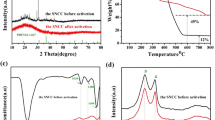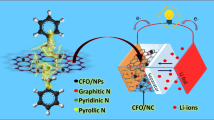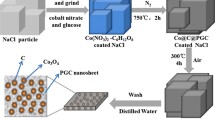Abstract
To overcome the inferior conductivity and ion transfer kinetics of MnO based on materials as lithium-ion batteries anode, microsized carbon coating MnO nanoparticles (HNC@MnO/NC) are designed by hard template and hydrothermal methods combined with the pyrolysis of polydopamine. The coating carbon layer and the presence of oxygen vacancies accelerate the electron transfer and promote the lithium storage performance of HNC@MnO/NC. The internal carbon of the HNC@MnO/NC nanoparticles is used to prevent MnO nanoparticles aggregation during the calcination process; the outer carbon layer not only effectively enhances the conductivity but also avoids the pulverization of MnO nanoparticles, decreasing the undesirable side reactions between the electrode and electrolyte. The HNC@MnO/NC manifests outstanding rate performance at 5 A g−1; its charge capacity and discharge capacity are 338.7 and 342.4mAh g−1. The excellent Li+ storage performance of HNC@MnO/NC indicates that it has potential feasibility in the practical application of good performance Li+ batteries.








Similar content being viewed by others
Data Availability
All data generated and analysed during this study are included in this published article and its supplementary information files.
References
Wei T-T, Peng P, Ji Y-R et al (2022) Rational construction and decoration of Li5Cr7Ti6O25@C nanofibers as stable lithium storage materials. J Energy Chem 71:400–410
Yi TF, Sari HMK, Li X et al (2021) A review of niobium oxides based nanocomposites for lithium-ion batteries, sodium-ion batteries and supercapacitors. Nano Energy 85:105955
Yi T-F, Mei J, Peng P-P et al (2019) Facile synthesis of polypyrrole-modified Li5Cr7Ti6O25 with improved rate performance as negative electrode material for Li-ion batteries. Compos B Eng 167:566–572
Yi TF, Shi L, Han X et al (2020) Approaching high performance lithium storage materials by constructing hierarchical CoNiO2@CeO2 nanosheets. Energy & Environmental Materials 4(4):586–595
Xu P, Tan DHS, Chen Z (2021) Emerging trends in sustainable battery chemistries. Trends in Chemistry 3(8):620–630
Nie Y, Dai X, Wang J et al (2022) Facile and scalable fabrication of lithiophilic CuO enables stable lithium metal anode. J Energy Chem 75:285–292
Massaro A, Munoz-Garcia AB, Maddalena P et al (2020) First-principles study of Na insertion at TiO2 anatase surfaces: new hints for Na-ion battery design. Nanoscale Adv 2(7):2745–2751
AbdahMaa M, Mokhtar M, Khoon LT et al (2021) Synthesis and electrochemical characterizations of poly (3,4-ethylenedioxythiophene/manganese oxide coated on porous carbon nanofibers as a potential anode for lithium-ion batteries. Energy Reports. 7:8677–8687
Colombo R, Garino N, Versaci D et al (2022) Designing a double-coated cathode with high entropy oxides by microwave-assisted hydrothermal synthesis for highly stable Li–S batteries. J Mater Sci 57(33):15690–15704
Bella F, De Luca S, Fagiolari L, Versaci D, Amici J, Francia C, Bodoardo S (2021) An overview on anodes for magnesium batteries: challenges towards a promising storage solution for renewables. Nanomaterials 11:810
Wang X, Wang Z, Wang L et al (2019) Dependency analysis and degradation process-dependent modeling of lithium-ion battery packs. J Power Sources 414:318–326
Wang J-G, Liu H, Liu H et al (2017) Facile synthesis of microsized MnO/C composites with high tap density as high-performance anodes for Li-ion batteries. Chem Eng J 328:591–598
Zhang H, Zhang Z, Luo JD et al (2019) Molten-salt-assisted synthesis of hierarchical porous MnO@Biocarbon composites as promising electrode materials for supercapacitors and lithium-ion batteries. Chemsuschem 12(1):283–290
Feng Q, Li H, Tan Z et al (2018) Design and preparation of three-dimensional MnO/N-doped carbon nanocomposites based on waste biomass for high storage and ultra-fast transfer of lithium ions. Journal of Materials Chemistry A 6(40):19479–19487
Zhang W, Li J, Zhang J et al (2017) Top-down strategy to synthesize mesoporous dual carbon armored MnO nanoparticles for lithium-ion battery anodes. ACS Appl Mater Interfaces 9(14):12680–12686
Yang B, Chen J, Liu B et al (2021) One dimensional graphene nanoscroll-wrapped MnO nanoparticles for high-performance lithium-ion hybrid capacitors. Journal of Materials Chemistry A 9(10):6352–6360
Li H, Jiang L, Feng Q et al (2019) Ultra-fast transfer and high storage of Li+/Na+ in MnO quantum dots@carbon hetero-nanotubes: appropriate quantum dots to improve the rate. Energy Storage Materials 17:157–166
Rana M, Sai Avvaru V, Boaretto N et al (2019) High-rate hybrid MnO2@CNT fabric anodes for Li-ion batteries: properties and a lithium storage mechanism study by in situ synchrotron X-ray scattering. Journal of Materials Chemistry A 7(46):26596–26606
Zhou F, Li S, Han K et al (2021) Polymerization inspired synthesis of MnO@carbon nanowires with long cycling stability for lithium-ion battery anodes: growth mechanism and electrochemical performance. Dalton Trans 50(2):535–545
**ao Z, Ning G, Ma X et al (2019) Hydrothermal assembly of MnO-graphene core-shell nanowires with superior anode performance. Carbon 142:461–467
Zhang Y, Chen P, Gao X et al (2016) Nitrogen-doped graphene ribbon assembled core–sheath MnO@Graphene scrolls as hierarchically ordered 3D porous electrodes for fast and durable lithium storage. Adv Func Mater 26(43):7754–7765
Sun Q, Wang S, Ming H et al (2020) Self-catalytic approach to construct graphitized carbon shell for metal oxide: In-situ triggering mechanism and high-performance lithium-ion batteries applications. J Power Sources 227631
Hu Y, Wu K, Zhang F et al (2018) Hierarchical MnO@C hollow nanospheres for advanced lithium-ion battery anodes. ACS Applied Nano Materials 2(1):429–439
Qian X, ** L, Zhao D et al (2016) Ketjen Black-MnO composite coated separator for high performance rechargeable lithium-sulfur battery. Electrochim Acta 192:346–356
Qi W, Rui Y, Zi Z, Huai L, Rong J (2021) Double core–shell structure H-TiO2/C/Fe3O4@rGO for Li+ battery anodes with long cyclability. Appl Surf Sci 559:227631
Wu H, Li Y, Ren J et al (2019) CNT-assembled dodecahedra core@nickel hydroxide nanosheet shell enabled sulfur cathode for high-performance lithium-sulfur batteries. Nano Energy 55:82–92
Yao D, Wang F, Lei W et al (2020) Oxygen vacancies boosting ultra-stability of mesoporous ZnO-CoO@N-doped carbon microspheres for asymmetric supercapacitors. Sci China Mater 63(10):2013–2027
Zhai T, **e S, Yu M et al (2014) Oxygen vacancies enhancing capacitive properties of MnO2 nanorods for wearable asymmetric supercapacitors. Nano Energy 8:255–263
Cao W, Yan J, Zhang P et al (2022) Cerium-doped lithium-rich Li1.2Mn0.56Ni0.11Co0.13O2 as cathode with high performance for lithium-ion batteries. Ionics 28(10):4515–4526
Khan RA, Akhoon SA, Vijayaraghavan GV et al (2022) The novel LiMn1.8Al0.2O4 nanosheets for high energy and power density supercapacitor cathode applications. Ionics 28(10):4805–4815
Liang S, Teng F, Bulgan G et al (2008) Effect of phase structure of MnO2 nanorod catalyst on the activity for CO oxidation. The J of Phys Chem C 112(14):5307–5315
Hadžić B, Vasić B, Matović B et al (2018) Influence of laser-induced heating on MnO nanoparticles. J Raman Spectrosc 49(5):817–821
Jiang Y, Ba D, Li Y et al (2020) Noninterference revealing of “Layered to Layered” zinc storage mechanism of delta-MnO2 toward neutral Zn-Mn batteries with superior performance. Adv Sci (Weinh) 7(6):1902795
Qian J, Ming L, Chang S et al (2020) Nitrogen do** polyvinylpyrrolidone-based carbon nanofibers via pyrolysis of g-C3N4 with tunable chemical states and capacitive energy storage. Electrochim Acta 330:135212
Meng JQ, Zhang JJ, Lu DH et al (2022) Heterostructural Li1+xMn2xO4 cathode materials of high performance for aqueous lithium-ion batteries. Ionics 28(12):5405–5413
Zheng F, Yin Z, **a H et al (2017) Porous MnO@C nanocomposite derived from metal-organic frameworks as anode materials for long-life lithium-ion batteries. Chem Eng J 327:474–480
Yao D, Wu Z, Song J et al (2020) Oxygen vacancy modulated LiMnxOy@C three-dimensional nanosheet arrays on nickel foam for lithium-ion capacitor with high performance. ACS Applied Energy Materials 3(5):4840–4851
Lin J, Zeng C, Lin X et al (2021) Metal-organic framework-derived hierarchical MnO/Co with oxygen vacancies toward elevated-temperature Li-ion battery. ACS Nano 15(3):4594–4607
Jia H, Cai Y, Lin J et al (2018) Heterostructural graphene quantum dot/MnO2 nanosheets toward high-potential window electrodes for high performance supercapacitors. Adv Sci (Weinh) 5(5):1700887
Tite T, Chiticaru EA, Burns JS et al (2019) Impact of nano-morphology, lattice defects and conductivity on the performance of graphene based electrochemical biosensors. J Nanobiotechnology 17(1):101
Zhou T, Chang L, Li W et al (2020) Visualization of crystal plane selectivity for irreversible phase transition in MnO@C anode. Chem Commun (Camb) 56(26):3753–3756
Kim H, Choi W, Yoon J et al (2020) Exploring anomalous charge storage in anode materials for next-generation Li rechargeable batteries. Chem Rev 120(14):6934–6976
Cai Z, Xu L, Yan M et al (2015) Manganese oxide/carbon yolk-shell nanorod anodes for high capacity lithium batteries. Nano Lett 15(1):738–744
Liu H, Li Z, Liang Y et al (2015) Facile synthesis of MnO multi-core@nitrogen-doped carbon shell nanoparticles for high performance lithium-ion battery anodes. Carbon 84:419–425
Ma S, Chen D, Wang WL (2016) MnO nanoparticles embedded in a carbon matrix as high-performance lithium-ion battery anodes: preparation, microstructure and electrochemistry. Phys Chem Chem Phys 18(28):19130–19136
Chen B, Huang Z, Chen X et al (2016) A new composite solid electrolyte PEO/Li10GeP2S12/SN for all-solid-state lithium battery. Electrochim Acta 210:905–914
Sheng L, Liang S, Wei T et al (2018) Space-confinement of MnO nanosheets in densely stacked graphene: ultra-high volumetric capacity and rate performance for lithium-ion batteries. Energy Storage Materials 12:94–102
Zhu C, Fang G, Liang S et al (2020) Electrochemically induced cationic defect in MnO intercalation cathode for aqueous zinc-ion battery. Energy Storage Materials 24:394–401
Funding
The work was supported by the National Natural Science Foundation of China (Nos.52161145503, 51972173) and the Fundamental Research Funds for the Central Universities of China (No.30922010502). We also thank the support of the Analysis and Test Center, Nan**g University of Science and Technology.
Author information
Authors and Affiliations
Corresponding authors
Additional information
Publisher's note
Springer Nature remains neutral with regard to jurisdictional claims in published maps and institutional affiliations.
Supplementary Information
Below is the link to the electronic supplementary material.
Rights and permissions
Springer Nature or its licensor (e.g. a society or other partner) holds exclusive rights to this article under a publishing agreement with the author(s) or other rightsholder(s); author self-archiving of the accepted manuscript version of this article is solely governed by the terms of such publishing agreement and applicable law.
About this article
Cite this article
Chen, Z., Song, J., Zhang, B. et al. Double-carbon coated MnO nanoparticles as high-performance anode materials for lithium-ion storage. Ionics 29, 483–496 (2023). https://doi.org/10.1007/s11581-022-04825-8
Received:
Revised:
Accepted:
Published:
Issue Date:
DOI: https://doi.org/10.1007/s11581-022-04825-8




